I was under the TJ a couple of weeks ago when I noticed some rather mangled rubber bushing material coming out of my RE upper control arm on the front driver’s side. I realized that this one of the arms that a local shop had torqued down to over 250 ft. lbs. when they had done some work on my TJ (next time, they will die before they put an air tool on my TJ!). I caught and corrected the problem several weeks later, but I wondered if the excess pressure on that bracket might have caused damage to the bushing. Well, I don’t know if that caused the bushing failure, but I feel certain it sure didn’t help it. The remaining bushings in the other RE arms still appear to be doing just fine.
So, I talked with a couple of friends and discovered that the bushings from the factory arms (you know, the ones you took off your TJ when you lifted it) are used in the RE lower arms. GREAT! I had a stash of arms in the garage so the confidence factor for good donor bushings was running high. I talked with some other friends who have done a RE bushing replacement to see how they went about it. Armed with a few facts and a scattering of tools, I thought I would give it a try.
This first section covers the scavenging of the bushings from the factory control arms. The second section details the removal and installation of the bushings in the RE arms.
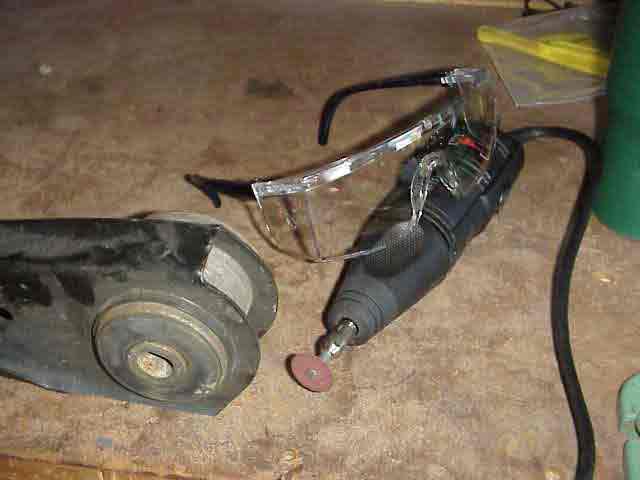
Here are 3 of the 4 necessary items I used for the salvage phase of this project. As I was using a high speed cutting disc on the end of my dremel tool (ok, it came from Sears), I grabbed a pair of safety glasses from the shelf. PLEASE remember to wear the proper safety equipment when working in the shop or garage. The couple of bucks spent on a pair of glasses, like those above, are well worth the investment. If you have ever used the cutting discs before, you already know they can easily shatter and launch the pieces in any direction. Don’t take a chance with your eyes!

With the glasses on a some clear bench space, I got down to the task of freeing the bushing from the factory arms. Since I had no use for the old arms, I opted for the easier destructive method of bushing removal. In the above pic, I am making the first of 3 cuts on this end of the control arm. I was originally made 4 but found that I could accomplish the task with just 3 and save a little time while doing so.
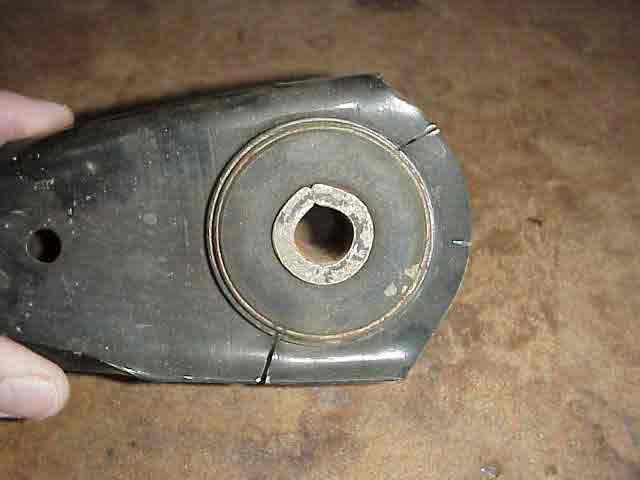
You can see the two cuts I’ve made on the control arm. Your cuts do not have to be exactly where I placed mine. I was careful not to slice into the metal sleeve that encases the rubber bushing. Take your time and you can do it too.
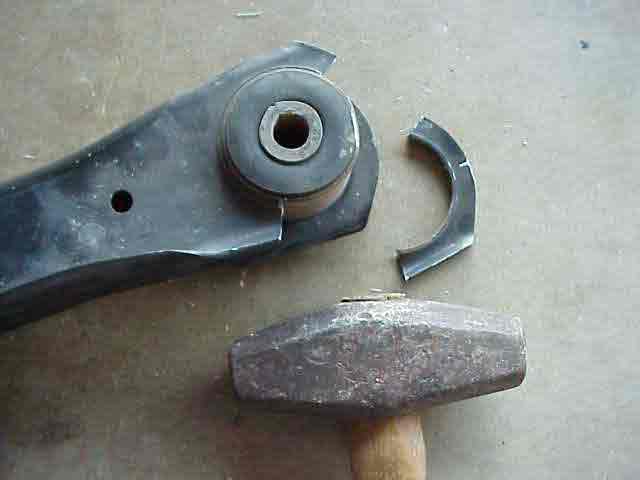
The 4th item used in the bushing salvage phase was a good sized hammer. With the initial two cuts almost through the control arm, a couple of whacks with the hammer caused the cut piece to snap right off. Piece of cake!
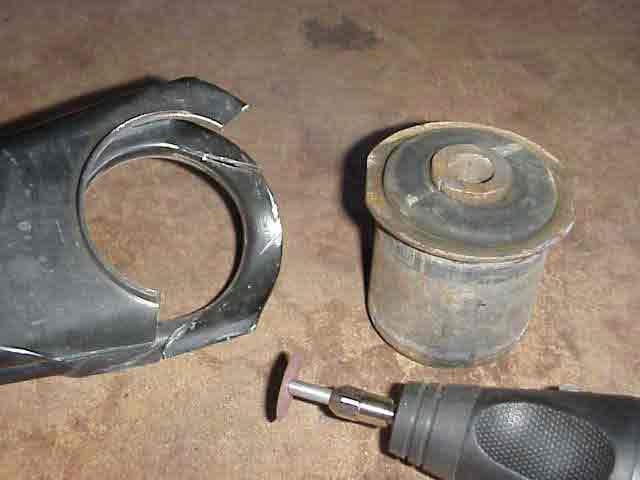
This was the first bushing I removed. As you can see in the picture, I also made two cuts on the other side of the arm. I found, after removing the next bushing, that only one cut was necessary. One the cut was made, the pressure was released and the bushing was easily knocked out of the remaining portion of the control arm. I used a single cut, for tihs step, on the remaining bushings and it worked just fine.
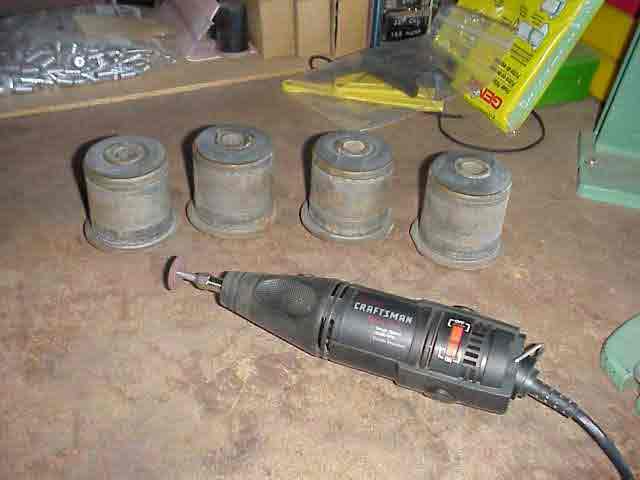
And there you have it. Four salvaged bushings, ready for transplant into the RE arms. I guess I could have save the 30 or 40 minutes I spent doing this and bought brand new bushings (NOT!). There was nothing wrong with these and the money saved can be put towards something else.
So, with a few recycled bushing at my disposal, I tossed them into the TJ and headed on over to my friend’s place. If you’ve read some of the other write-ups on here, you’ll remember me talking about Alan. He was up to his elbows in my 4:1 t-case rebuild and swap, not to mention and number of other things that have been done on my Jeep in the past couple of years. Alan lets me play with his 25 ton press (with supervision of course) when I need to push stuff in and out of tight fitting places. Although several good friends had given me a number of ideas on how to extract and install the bushings in the RE control arms, I decided to use the press and see how it worked.
After removing both of the the control arm bolts, I dropped the arm so I could get a better look at the bushing. Remember, I mentioned that I had seem some rubber working its way out of the driver’s side LCA so this was the first one I pulled off.
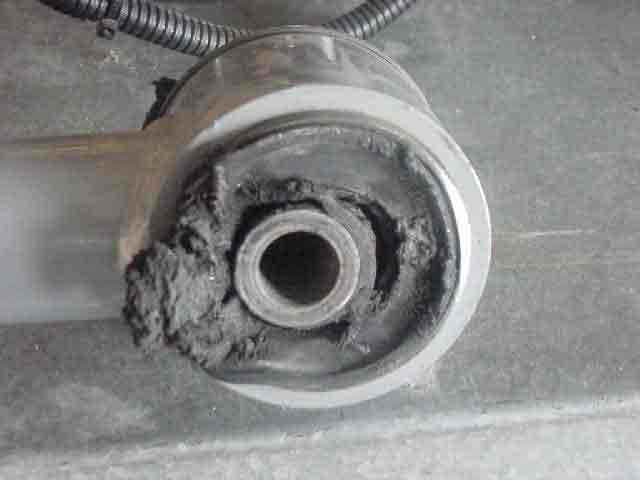
I was quite surprised to see just how badly the bushing was damaged. Although the center sleeve did not come all the way out, I could push it about an inch back and forth. It was all but ripped loose from the surrounding rubber bushing. One thing for sure, it would have been little or no time before I would have heard this one clunking on the trail and then on the street.
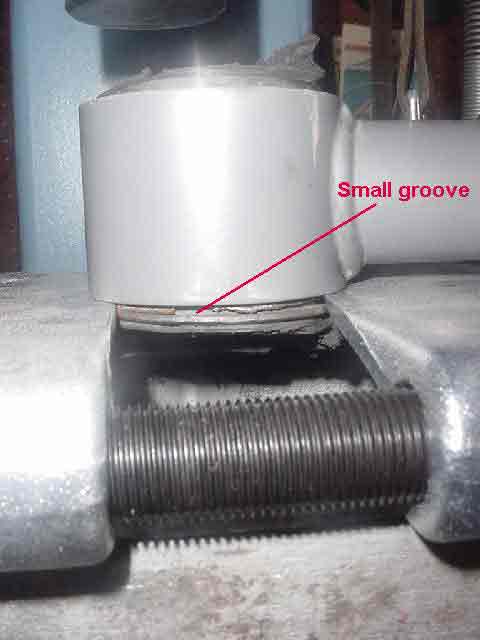
Alan and I discussed what was available in the tool box (in the way of things to hold and push with for his press) and decided that a bearing puller would be about the best thing to use to remove the bushing from the control arm. The above shot is a close-up of the bearing separator in use. We loosely clamped it on to the small (but important) groove that exists on one side of the bushing.
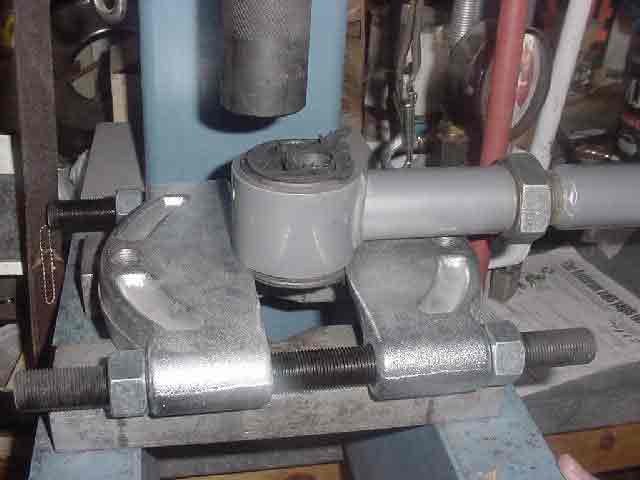
With something (the bearing separator) for the control arm to rest on, it was now just a matter of lining up the bushing under the press ram and pushing the old bushing through. Alan has a variety of cylinder shaped slugs that he uses to between the ram and the work piece so as to effectively change the diameter of the ram. We found one that would work and go it lined up so it would catch the lip of the bushing’s outer shell as it was pushed down by the ram.
After the old bushing was removed, we checked the inner surface of the control arm end to make sure there were no foreign material left behind that would interfere with the insertion of the new bushing. It looked good so we continued on with the replacement. Half way done and half way to go.
Pushing the new bushing into the control arm was easier than removing the old one. We had about 3/4 of the busing pressed in when we noticed a sharp increase in ram pressure. We had been pushing about a ton or so on the gauge but now it was climbing up towards the 10 ton mark. Neither of us could determine why the jump in ram pressure so we opted to stop the insertion and repeat the removal process (since it is non-destructive) and have a look at the bushing.
Sure enough, once we had pushed it back out, we noticed that the last 1/2″ of outer shell, near the end of the bushing with the metal flange on it, was just a bit bigger in diameter than the rest of the shell. Apparently, one side of the stock control arm has a slightly bigger I.D. as compared to the other side.
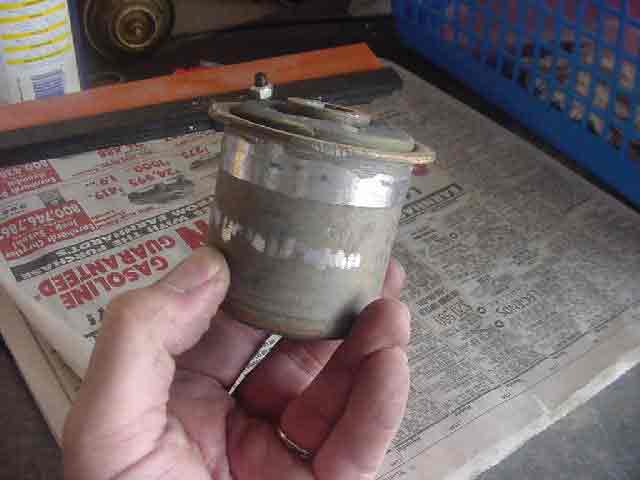
Not a problem….a quick stop at the bench grinder (see above pic) took care of that little shoulder. I did not grind it down to the same dimension as the other part of the bushing shell, but rather took off a bit so that it would slip easier into the RE control arm.
I sprayed some WD-40 onto the outer shell of the bushing and we lined everything back up on the press. The pressure went up to about 5 tons when we hit this last section, but it continued to push through and we finished the insertion with no more surprises.
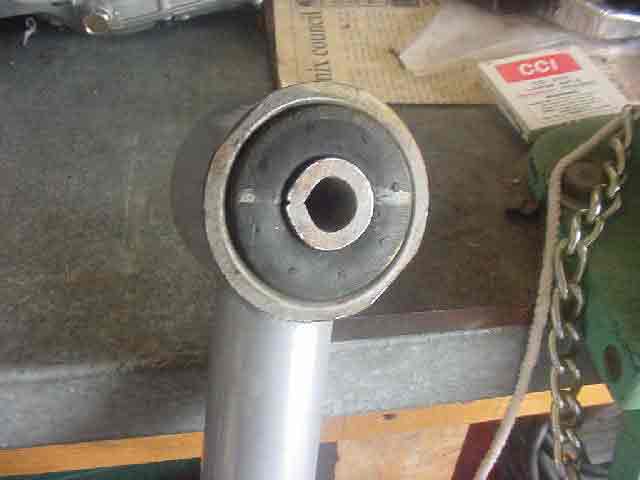
Here is a shot of the finished arm. It looks as good as when I put it on. I made sure not to press the new bushing all the way flush to the control arm. By doing this, I ensured myself that the little groove would be there for the bearing separator for the next overhaul. (and hopefully that won’t be for a while).
Since we had all of the tools out and I was already dirty from rolling around under the TJ, we popped the passenger LCA off so we could replace that bushing too. Although it did not look “perfect”, it was in much better shape than the other bushing was. We went ahead and replaced it too. Although we didn’t keep track of the time, both Alan and I agreed that it probably took about 10 minutes from start to finish (which included torquing the arm back in place after the bushing was replaced).
Note: I have not verified this personally, but I saw a posting on a forum that states that Moog PN# K3131 will get you a pair of stock replacement bushings. Also, the NAPA part number for the upper is NCP267-1372 and the lower is NCP267-3409.
Another unverified part number: I received an e-mail from a TJ owner who just overhauled his upper control arm bushings. He said that TRW #12680 was a perfect fit and that there was no shoulder on the outer shell to grind down.
